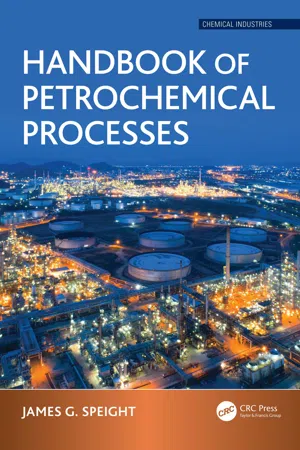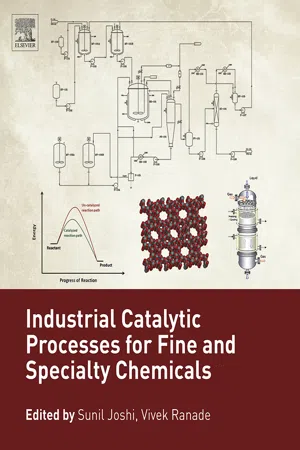Chemistry
Reactions of Aromatic Hydrocarbons
Reactions of aromatic hydrocarbons involve various chemical transformations of compounds containing benzene rings. These reactions can include electrophilic aromatic substitution, where an electrophile replaces a hydrogen atom on the benzene ring, and nucleophilic aromatic substitution, where a nucleophile replaces a substituent on the benzene ring. These reactions are important in the synthesis of many organic compounds.
Written by Perlego with AI-assistance
Related key terms
Related key terms
1 of 4
Related key terms
1 of 3
5 Key excerpts on "Reactions of Aromatic Hydrocarbons"
- eBook - ePub
- James G. Speight(Author)
- 2019(Publication Date)
- CRC Press(Publisher)
Aromatic compounds are characterized by having a stable ring structure due to the overlap of the π-orbitals (resonance). Accordingly, they do not easily add to reagents such as halogens and acids as do alkenes. Aromatic hydrocarbon derivatives are susceptible, however, to electrophilic substitution reactions in presence of a catalyst. Aromatic hydrocarbon derivatives are generally nonpolar. They are not soluble in water, but they dissolve in organic solvents such as hexane, diethyl ether, and carbon tetrachloride.In the traditional chemical industry, aromatic derivatives such as benzene, toluene, and the xylene were made from coal during the course of carbonization in the production of coke and town gas. A much larger volume of these chemicals are now made as refinery byproducts. A further source of supply is the aromatic-rich liquid fraction produced in the cracking of naphtha or low-boiling gas oils during the manufacture of ethylene and other olefin derivatives.Aromatic compounds are valuable starting materials for a variety of chemical products. Reforming processes have made benzene, toluene, xylene, and ethylbenzene economically available from petroleum sources.In the catalytic reforming process, a mixture of hydrocarbon derivatives with boiling points between 60°C and 200°C (140°F–390°F) is blended with hydrogen and then exposed to a bifunctional platinum chloride or a rhenium chloride catalyst at 500°C–525°C (930°F–975°F) and pressures ranging from 120 to 750 psi. Under these conditions, aliphatic hydrocarbon derivatives form rings and lose hydrogen to become aromatic hydrocarbons. The aromatic products of the reaction are then separated from the reaction mixture (the reformate) by extraction using a solvent such as diethylene glycol (HOCH2 CH2 OH) or sulfolane:The benzene is then separated from the other aromatic derivatives by distillation. The extraction step of aromatics from the reformate is designed to produce a mixture of aromatic derivatives with lowest nonaromatic components. Recovery of the aromatic derivatives commonly referred to as benzene, toluene and xylene isomers, involves such extraction and distillation steps. - eBook - ePub
- James G. Speight(Author)
- 2019(Publication Date)
- Gulf Professional Publishing(Publisher)
Neither positive ions nor negative ions are attracted to a nonpolar molecule. However, the unsaturated hydrocarbon derivatives do offer varying degrees of reactivity.It is not the purpose of this section to present a comprehensive review of the chemical reactions of hydrocarbon derivatives but to present an overview of the types of reactions of hydrocarbon derivatives that can be of use for the commercial production of saleable products.7.1. Alkylation
Alkylation is the transfer of an alkyl group from one molecule to another. The alkyl group may be transferred as an alkyl carbocation, a free radical, a carbanion, or a carbene. An alkyl group is a piece of a molecule with the general formula CnH2n +1, where n is the integer depicting the number of carbons linked together. For example, a methyl group (n=1, CH3 ) is a fragment of a methane molecule (CH4 ). Alkylating agents use selective alkylation by adding the desired aliphatic carbon chain to the previously chosen starting molecule. This is one of many known chemical syntheses. Alkyl groups can also be removed in a process known as dealkylation.Carbon alkylation is a process for the formation of carbon-carbon bonds and for this types of reaction, the electrophilic nature of alkyl halides is enhanced by the presence of a Lewis acid, such as aluminum trichloride (AlCl3 ). The carbon alkylation reaction can also be effected by alkene derivatives in the presence of acids.Nitrogen alkylation is an important process for the formation of carbon-nitrogen bonds. Amines are readily alkylated and the rate of alkylation follows the order tertiary amine<secondary amine<primary amine. As an example, a tertiary amine can be converted into a quaternary ammonium salt by reaction with an alkyl (hailed the Menshutkin reaction):Alcohol derivatives can also be alkylated to yield ethers derivatives: for example, using an alkyl halide (the Williamson ether synthesis)ROH+R1 X → ROR1Alcohols are also good alkylating agents in the presence of suitable acid catalysts. For example, most methyl amines are prepared by alkylation of ammonia with methanol. The alkylation of phenols is particularly straightforward, since it is subject to fewer competing reactions. - eBook - ePub
Organic Reaction Mechanisms 2012
An annual survey covering the literature dated January to December 2012
- A. C. Knipe, A. C. Knipe(Authors)
- 2015(Publication Date)
- Wiley(Publisher)
Chapter 5 Aromatic Substitution M.R. Crampton Department of Chemistry, University of Durham, Durham, UK- Introduction
- General
- Nucleophilic Substitutions
- The SN Ar Mechanism
- Meisenheimer and Related Complexes
- Benzyne and Related Intermediates
- Electrophilic Substitutions
- Halogenation
- Nitration
- Alkylation, Arylation, and Acylation
- Other Reactions
- Transition-metal-catalysed Carbon–Carbon Bond Formation
- Alkylation, Arylation, and Acylation
- Transition-metal-catalysed Substitution on Heterocyclic Rings
- References
Introduction
In recent years, there has been a dramatic increase in the use of transition metal catalysts to effect carbon–carbon bond formation in reactions involving arenes. Substitutions at ring positions carrying either hydrogen or electronegative groups, such as halogens, are often connected mechanistically. So, this year, the chapters on nucleophilic and electrophilic substitutions have been combined into a single chapter including a large section on transition-metal-catalysed carbon–carbon bond formation. This follows sections involving relatively traditional nucleophilic and electrophilic mechanisms. - eBook - ePub
- James G. Speight(Author)
- 2010(Publication Date)
- Gulf Professional Publishing(Publisher)
aliphatic hydrocarbons).Benzene and other aromatic compounds can have substituents. When benzene itself is a substituent, it is called a phenyl group. Benzene is typically drawn in such a way that the hybrid between the resonance structures is emphasized:However, not every conjugated cyclic system is aromatic since not all are stabilized by resonance, mainly due to differences in filling molecular orbitals with electrons.Benzene is obviously an unsaturated hydrocarbon because it has far less hydrogen than the equivalent saturated hydrocarbon: cyclohexane, C6 H12 . But benzene is too stable to be an alkene or alkyne. Alkenes and alkynes rapidly add bromine (Br2 ) to the C=C or CC bonds, whereas benzene only reacts with bromine in the presence of a catalyst: ferric bromide (FeBr3 ). Furthermore, when benzene reacts with Br2 in the presence of FeBr3 , the product of this reaction is a compound in which a bromine atom has been substituted for a hydrogen atom, not added to the compound in the way an alkene adds bromine:Other compounds were eventually isolated from coal that had similar properties. Their formulas suggested the presence of multiple C=C bonds, but these compounds were not reactive enough to be alkenes.The structure of benzene was a recurring problem throughout most of the nineteenth century. The first step toward solving this problem was taken by Friedrich August Kekulé in 1865. (Kekulé’s interest in the structure of organic compounds may have resulted from the fact that he first enrolled at the University of Giessen as a student of architecture.) One day, while dozing before a fire, Kekulé dreamed of long rows of atoms twisting in a snakelike motion until one of the snakes seized hold of its own tail. This dream led Kekulé to propose that benzene consists of a ring of six carbon atoms with alternating C–C single bonds and C=C double bonds. Because there are two ways in which these bonds can alternate, Kekulé proposed that benzene was a mixture of two compounds in equilibrium. - Sunil S Joshi, Vivek V. Ranade(Authors)
- 2016(Publication Date)
- Elsevier(Publisher)
Chapter 14Carbonylations and Hydroformylations for Fine Chemicals
A.A. Kelkar Chemical Engineering and Process Development Division, National Chemical Laboratory, Pune, IndiaAbstract
Carbonylation reactions (hydroformylation and carbonylation) constitute one of the most powerful tools for C" src="../Images/B9780128014578000148/glyph_sbnd.gif" alt="glyph_sbnd"/>C bond formation in organic synthesis and represent an outstanding example of the application of homogeneous catalysis on an industrial scale. Carbonylation reactions have the potential to provide clean, atom-efficient routes for the synthesis of molecules with carboxylic acid, aldehyde and amide functional groups. However, catalyst product separation is a major problem for the application of homogeneous catalysts on an industrial scale. The manufacture of ibuprofen, one of the important antiinflammatory drugs involving palladium-catalyzed carbonylation, was the path-breaking technology in pharmaceutical chemistry. A significant amount of work is being carried out on the development of selective catalysts for specialty chemical synthesis. This chapter presents recent advances in the development of new catalysts for carbonylation reactions. Various strategies developed for the heterogenization of catalysts are also presented, with an emphasis on specialty chemicals.Keywords
Homogeneous catalysis; Hydroformylation; Carbonylation; Heterogenization of homogeneous catalysts14.1 Introduction
The development of environmentally benign and clean synthetic methodologies is one of the most important goals of current research in chemistry. Conventional technologies for pharmaceuticals and fine chemicals are mostly chemistry intensive, with a focus on products with desired purity and productivity. These synthetic routes also have the drawbacks of generating significant quantities of waste, with inorganic salts as by-products, and of using corrosive and toxic reagents. However, because of strict environmental regulations and increasing competition, the emphasis of the work is on the development of environmentally cleaner and atom-efficient synthetic routes. Catalysis has made a significant impact in the development of innovative processes, new competitive technologies and environmental compatibility. Homogeneously catalyzed carbonylation and hydroformylation reactions are particularly attractive in this context. They have the potential to provide clean, atom-efficient routes for the synthesis of molecules, with carboxylic acid, aldehyde and amide functional groups to replace stoichiometric, multistep routes using toxic and hazardous reagents [1 ,2
Index pages curate the most relevant extracts from our library of academic textbooks. They’ve been created using an in-house natural language model (NLM), each adding context and meaning to key research topics.
Explore more topic indexes
Explore more topic indexes
1 of 6
Explore more topic indexes
1 of 4




